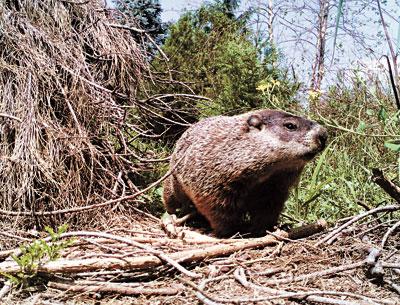Nature Notes: If a Woodchuck Could Chuck

Punxsutawney Phil in Pennsylvania and Staten Island Chuck didn’t see their shadows on Saturday while Malverne Mel and Holtsville Hal did. It’s hard to believe that Pennsylvanians and Staten Islanders will be blessed with an early spring, while we Long Islanders will suffer prolonged winter, as we are relatively close to those areas and prevailing climate conditions stretch for hundreds of miles. What weather conditions eastern Pennsylvania has, we should also enjoy.
Groundhogs and woodchucks may differ as weathermen, but they share one major attribute, wherever they may roam they are one and the same species, Marmota monax, and except for beavers, they are the largest rodents in North America. And, along with the eastern chipmunk and bats, they are the only truly hibernating mammals we have on Long Island. If they had anything to say about it, notwithstanding their appearances in the newspapers and on television every February, Phil and the rest of them would almost certain prefer not to be roused from a sleep that would otherwise extend into April for 15 seconds of fame.
According to Webster’s Collegiate Dictionary, the name “woodchuck” comes from the Ojibwa Indian word, otchig, which also applied to two members of the weasel family, the fisher and the marten. The Cree Indians called groundhogs and the like otchecks. “How much wood could a woodchuck chuck if a woodchuck could chuck wood?” was a standard limerick line in my kindergarten days in Mattituck on the North Fork.
We recited the jingle before we saw the woodchuck in real life. I was 8 when I saw this largish brown furry animal with large buckteeth approach me from inside my grandfather’s chicken yard. I was on one side of the wire fence, it was on the other side. It studied me as much as I studied it. I had no inkling at the time that I was looking at a woodchuck, a quite friendly one at that, and the only one I ever saw until I saw another nine years later come out from under a pile of branches on the dairy farm down the street from my house in the Oregon Road area of Mattituck. That one became a regular and I would visit it often.
The next woodchucks to cross my eyes were in a field north of Riverhead in Northville, close to the old Iron Pier on Long Island Sound. It turned out that in the mid-1950s the population began to build rapidly, the way the deer population began to build in the 1960s. In those days people didn’t hunt woodchucks, they weren’t much good for eating, their pelts didn’t fetch a farthing, and rifle shooting in the field was banned on Long Island.
However, during my Cornell years upstate in dairy farming country, woodchucks were common and they were a solid fixture in the “varmint” category. They would be shot with .22-caliber rifles in a sport called “plinking” and left where they fell. It wasn’t until 1974 when I came back from the West Coast to teach at Southampton College that I began to notice woodchucks through a biologist’s eye.
By then they had become rather common north of Riverhead and in fields and highway shoulders in western Southampton Town and eastern Brookhaven Town. Beginning in the 1980s in late spring through early fall, a motorist traveling along the L.I.E. or Sunrise Highway west of Hampton Bays through the Central Pine Barrens was bound to encounter a woodchuck or two. They dug their burrows in the banks behind the road shoulders and fed on the vegetation in the shoulders. Road kills began to show up regularly along those highways as well, as the grassy medians became a regular part of their foraging territories.
Nuisance trappers tending to complaints about raccoons and opossums began trapping woodchucks as well. One of Long Island’s longest-standing nuisance trappers and a close friend of mine, the late Pearson Topping, specialized in woodchucks. It was by way of my visits with him that I first found out that woodchucks are excellent climbers, just as the other of Long Island’s two hibernators, the chipmunks, are. Beavers, on the other hand, don’t climb trees; they cut them down.
It wasn’t until the late 1990s that woodchucks began to show up on the South Fork. It was just a matter of time before they expanded eastward. No one knows how they got here. Did they swim the canal or cross one of the bridges? But they did get here, and by all accounts are doing quite well. The first ones reported to me showed up south of Bridgehampton near the ponds around Mecox Bay. About five years ago I got a call from a former supervisor of East Hampton Town, Bruce Collins, who lives off of Cedar Street in East Hampton. One was in his yard and he took a photograph of it.
I have yet to get a report of woodchucks having made it across the Napeague isthmus to reach Montauk, but more than likely come spring, one will be standing up in some Hither Hills spot next to its borough looking every bit like a big prairie dog. What will the Montaukers name it? Montauk Max, or Montauk Mary if it turns out to be a female? Next to its borough looking every bit like a big prairie dog. What will the Montaukers name it? Montauk Max, or Montauk Mary if it turns out to be a female?
